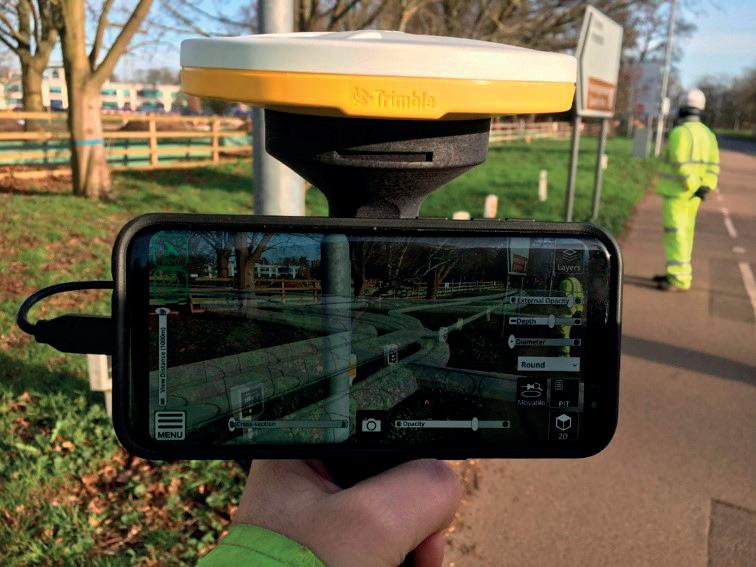
4 minute read
Working together on the roads of the future
from Annual Review 2023
by ITS_UK_Org
At National Highways we’re very proud to be an Executive member of ITS UK. The partnerships, insights and innovations we’ve developed are crucial to the success of our schemes and to achieving our vision for the strategic road network.
Today our motorways and A-roads are undergoing a once-in-a-century transformation thanks to the growth of digital, data and technology. We’re determined to harness their power to design, build and operate safer, greener and smoother roads.
Advertisement
The Challenges Ahead
We know that the UK’s population is set to grow. We also know, decades from now, people will continue to undertake most of their journeys by road.
We absolutely support the use of public transport and active travel, but people still value the freedom of personal transport, particularly for long distance journeys, and we don’t see that changing.
Then there’s the surge in online shopping which has permanently changed the nature of distribution logistics and led to more commercial vehicles on our roads.
It’s clear that the demands on our strategic road network will increase. Meanwhile we need to work towards achieving net zero carbon travel on our road network by 2050 while fulfilling our imperatives of safety, customers, and delivery.
Delivering Digital Roads
I’m pleased to say that our Digital Roads strategy, which we launched in 2021, is helping us to solve the many challenges we face.
At the heart of our strategy is our commitment to create one of the largest fibre networks in England. This will give us the connectivity ‘backbone’ we need to deliver the roads of the future.
We’re using digital technology in more of our design and construction activities. For example, by using rapid engineering modelling we’re increasing the speed, quality and safety of road design. This has reduced the time it takes to produce operational concepts for schemes from many months to a matter of weeks.
We’re also using drones to build 3D maps of the network, and we’re sharing these across project teams to streamline processes. Offsite fabrication, modular construction and – soon – connected and autonomous plant will be helping us to improve safety, reduce network disruption and cut carbon emissions. Our ambition is for connected and autonomous plant to be the norm on our construction sites by 2035.
Transformational Technologies
As a trained engineer, I find digital twin modelling a particularly fascinating area and one that will revolutionise how we operate and maintain our many thousands of road assets.
Through our collaboration with partners, including fellow ITS UK members, the time is coming when we’ll produce a digital twin for every new scheme. This digital version of a road or bridge will enable us to replicate what we plan to do with the asset in the real world so we can better manage its performance throughout its lifetime. Meanwhile we’re implementing the use of artificial intelligence and machine learning to prolong the life of bridges, structures and roads which can be monitored remotely. We’re managing traffic flow more effectively through real-time data sharing and automated variable messages. And we’re improving how we communicate with our customers. We’re exploring ways to enable seamless end-to-end journeys, working with other transport networks and journey planning providers so customers can access accurate information via their smartphone or sat nav.
Making Connections
I’ve already touched on connected and autonomous plant, but what about other connected and autonomous vehicles?
We’ve teamed up with other ITS members within the Connected Vehicles Forum to explore initiatives and undertake trials, including connected and autonomous vehicles infrastructure appraisal readiness (CAVIAR).
On the A2/M2 connected corridor we’ve tested in-vehicle signage, roadwork warnings and other services. We’ve also trialled HGV platooning technology elsewhere on the network through the HelmUK initiative. These activities have influenced our safety risk guidance for connected and autonomous vehicle trials, published in 2022.
If we can get this technology right and smooth out issues around data sharing, for example, we have a real chance to drastically improve traffic flow and reduce traffic incidents by around 90%. That will be a gamechanger for achieving our aim of zero harm on the strategic road network by 2040.
Towards Net Zero Carbon

I haven’t yet touched on climate change, which poses an existential threat to every human on the planet, yet technology has massive potential to mitigate this change.
I’m very proud that National Highways is the first roads organisation in the world to achieve the globally recognised PAS 2080 accreditation. This highlights our commitment to reducing carbon during the design, construction and operation of our strategic road network.
We aim to achieve net zero for our own operations by 2030, to deliver net zero road maintenance and construction by 2040 and to support net zero carbon travel on our road network by 2050.
Making The Journey Together
It’s impossible to predict how the world will be in 100 years’ time, particularly when we expect to see more change in the next decade than we have in the last century. What we can be sure of is that data, digital and technology will be fundamental to the many leaps forward that humankind will make. However, they alone won’t guarantee success. Behaviour change will.
We must take our customers on the journey with us if we are to succeed. That means building partnerships and alliances and engaging with our stakeholders.
At National Highways we will be continuing our work with vehicle manufacturers and industry bodies, our supply chain, sub-national transport bodies, academia and the many communities and interest groups we engage with to improve customer awareness and drive change.
And, of course, we’re looking forward to continuing our work with you, our fellow members of ITS UK. Your support will enable us to achieve our vision for Digital Roads, to deliver on many of our RIS2 goals and achieve our imperatives of safety, customer and delivery. And it will support our commitment to be net zero by 2050. Above all, your support will be key to helping us achieve the government’s ambition of the UK being a world leader in shaping the future of transport.
Siobhan Campbell Technical Director, WSP











